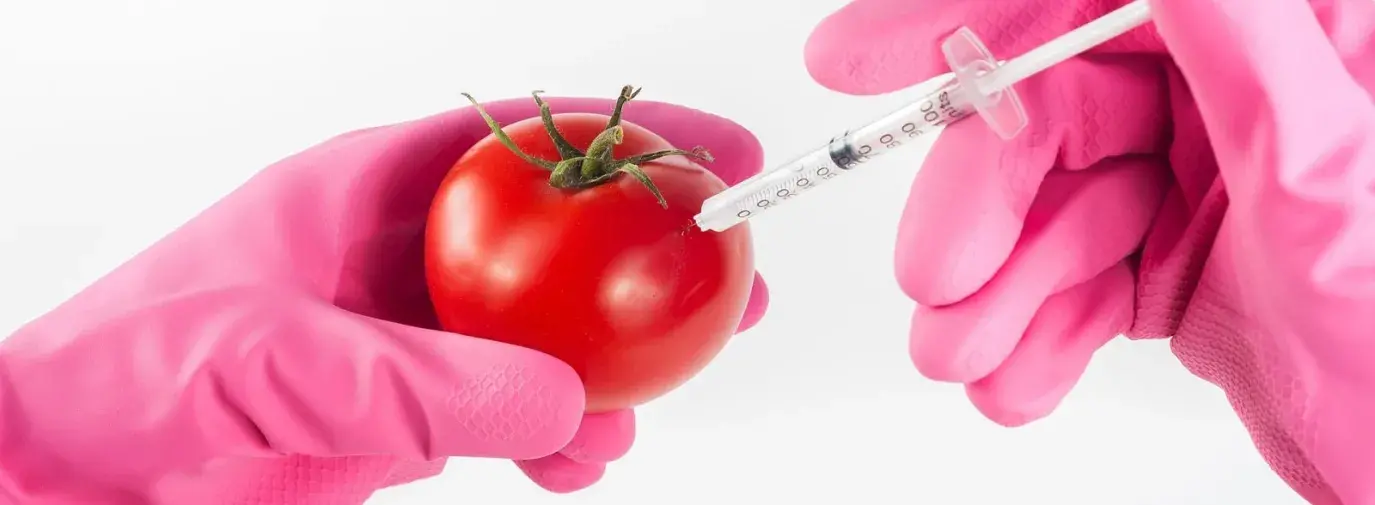
In 1998, a group of scientists, lawyers, and environmental advocates gathered at the Wingspread Cnference Centerin Racine, WI, to discuss the case for exercising precaution in the face of scientific uncertainty.
“We believe existing environmental regulations and other decisions, particularly those based on risk assessment, have failed to protect adequately human health and the environment—the larger system of which humans are but a part,” the attendees collectively wrote in what they called The Wingspread Statement on the Precautionary Principle.
The attendees urged corporations, government entities, organizations, communities, scientists, and other individuals to “adopt a precautionary approach to all human endeavors.”
|
WHAT IS GENETIC ENGINEERING? |
Then they defined exactly what that approach would be in a statement that would become known far and wide as The Precautionary Principle: When an activity raises threats of harm to human health or the environment, precautionary measures should be taken even if some cause and effect relationships are not fully established scientifically.
In other words, people shouldn’t have to prove that a given substance, product, or process is causing harm. Industry should have to prove that the substance, product, or process is safe.
If the Precautionary Principle had always been at the root of US policy:
• Cigarettes wouldn’t be responsible for one of every six deaths in the US.
• Children in four million US households wouldn’t currently be exposed to unsafe levels of the neurotoxicant lead.
• Three million Vietnamese wouldn’t have been killed, maimed, or born with birth defects caused by Agent Orange, which was used as a defoliant during the Vietnam War. And US Vietnam War veterans wouldn’t currently experience a higher incidence of cancer and nerveand respiratory disorders.
• DDT wouldn’t have nearly decimated bald eagle, peregrine falcon, and other wildlife populations, and Rachel Carson never would have had to ask whether it was responsible for a rise in human cancer rates.
• The toxic effects of everything from asbestos to PCBs, lead to dioxin, might have been confined to a lab, rather than being unleashed on the public.
Since we published our “Frankenfood” issue of the Green American in the spring of 2012, Green America has been asking whether someday we’ll be adding genetically modified organisms (GMOs) to the list of toxins that wreaked havoc on human health and the environment in the absence of a precautionary approach. Can we prove beyond the shadow of doubt that GMOs are dangerous to human health? No. Nor can we prove that they’re safe.
That’s why Green America advocates for the use of the Precautionary Principle. GMOs have been unleashed into our food supply without adequate testing for safety to human health and the environment. We want them off the market and out of our bodies until adequate testing can occur.
 |
| People shouldn't have to prove that GMO food or the pesticides tailored to them are causing harm. Industry should have to prove that they are safe. |
Who’s Protecting Our Families?
A common argument from GMO advocates is that “nobody has gotten sick from eating GMOs, and they’ve been around for years.”
“It’s such garbage science,” says Dr. Doug Gurian-Sherman, a molecular biologist and plant pathologist who is a senior scientist with the Union of Concerned Scientists’ Food and Environment program. “You wouldn’t know these things are doing harm unless you do long-term epidemiological studies to detect these kinds of harm. And they’ve never been done for GMOs.”
Approval of GMO crops currently rests with the US Food and Drug Administration (FDA). “In 1991, the White House hired Michael Taylor, a former Monsanto attorney, to oversee the creation of GMO policy for the FDA,” says Jeffrey Smith, director of the Institute for Responsible Technology and a pioneering activist against GMOs. “Under Taylor’s watch, the FDA publicly claimed that GMOs were no different from comparable conventional foods. It said no testing of GMOs was required, and companies like Monsanto could determine whether their own products were safe.”
From 1996-2000, Taylor worked for Monsanto as Vice President for Public Policy. He is now back at the FDA as the agency’s “food safety czar.”
“It’s a clear conflict of interest,” says Smith. To this day, the FDA approves GM foods based largely on tests conducted by the biotech industry. Companies like Monsanto generally test their GMOs for a period of 90 days or less. Usually less, says Gurian Sherman.
“Tests over 90 days are very rarely done and never done for regulatory purposes,” he notes. “In the US, the longest required tests are only a month long, and only for pesticidal crops like Bt, because those are evaluated by the EPA. The FDA has no requirements for any kind of testing—it’s all voluntary.”
A study of 90 days or less can indicate short-term problems, but it can’t tell you whether there will be long-term effects, says Gurian-Sherman.
“If a GMO was acutely toxic and made people sick within a day, it would be detected pretty quickly [by the current regulatory process],” he says. But the fact that no long term tests are required for approval makes it impossible to be certain that GMOs don’t harm human health, despite Big Biotech’s ongoing assertions that these crops “have been proven safe.”
And independent studies are difficult to conduct in North America, because the biotech companies that own the patents on GMO seeds also have some control over who gets to study them.
“If you want to do research on GMOs in North America, you need an agreement from the patent holder,” says Dr. Thierry Vrain, a soil biologist and former plant genetic engineer. “You have to sign a document that you will observe certain rules and will tell them what you want to do and how you plan to do it—and that you will have their agreement before you can publish. Scientists are muzzled.”
However, scientists in Europe have managed to get around or ignore those agreements to study GMOs. And those studies are turning up warning signs that GMOs could be inflicting harm on humans and the environment.
 |
| Although evidence was mounting in the 1950s that cigarettes caused cancer, the tobacco industry spent millions influencing and manufacturing studies to demonstrate the opposite. Anti-GMO advocates worry that GMOs are being subjected to similar “tobacco science” tactics. |
Herbicides: The Biggest Health Risk
“People worry about genetic modification, but with herbicide-resistant crops, perhaps the biggest health risk is the huge amount of herbicides currently being used,” David Schubert, head of the cellular neurobiology lab at the Salk Institute in La Jolla, CA, told the Associated Press in April.
Monsanto’s Roundup herbicide, generic name glyphosate, is the most popular herbicide sold worldwide—with 187 million pounds of it sprayed in the US alone in 2007, according to the EPA. Several GM crops, including corn, soy, canola, and sugarbeets, are engineered to be “Roundup Ready,” or resistant to glyphosate. This allows farmers to spray the herbicide on their field and kill weeds, but not their crops.
While Monsanto once marketed Roundup as being “safer than table salt,” studies continue to mount that show potential links between glyphosate and ill health effects.
• A 2007 study conducted by Pontifical Catholic University of Ecuador found a higher degree of DNA damage—which leads to cancer—in populations that had been aerially sprayed with glyphosate, compared to those living 80 kilometers away from the sprayed area.
• In an article published in the August 2009 issue of Toxicology, researchers from the Universities of Caen and Burgundy in France reported that they’d exposed human cells to glyphosate and found it acted as a hormone disruptor. The first hormone disruption effects occurred at an exposure of .5 parts per million (ppm), which the authors note “is 800 times lower than the level authorized in some food or feed.” DNA damage, a precursor to cancer, occurred at exposures of 5 ppm.
• Argentine government scientist Andres Carrasco published a study in Chemical Research in Toxicology in 2010 on his study that linked low-dose glyphosate exposure to malformations in frog and chicken embryos.
• And a 2012 review of several studies conducted by scientists at King’s College London School of Medicine and other universities urged new risk assessments be conducted for Roundup, after review authors found evidence that glyphosate could cause birth defects. The authors called the European Union’s current acceptable daily intake level for glyphosate “potentially unsafe.”
And since the vast majority of GM crops are engineered to be resistant to one herbicide in particular, Roundup or glyphosate, farmers have been relying on this one single chemical, which has resulted in an epidemic of glyphosateresistant weeds. Biotech companies are currently engineering crops that will be resistant to even more toxic pesticides—namely dicamba and 2, 4-D—to combat them. Scientists predict that these new crops will cause herbicide use to double or even triple.
Precaution with Our Health
Even looking beyond pesticide applications, GM crops themselves could be causing human health problems.
Dr. Thierry Vrain used to genetically engineer plants as the head of biotechnology for Agriculture Canada’s Summerland Research Station. But when he retired 12 years ago and escaped what he calls “the biotech bubble,” he conducted more research that utterly reversed his way of thinking about his former career. Today, he speaks to audiences across North America about the potential dangers of GMOs.
“When you inject, push, shoot foreign genetic material into genome of a plant, you are creating collateral damage, because the genome is not what we thought 30-40 years ago when we first had the idea of doing genetic engineering,” he says.
“The idea was that the genome contains about five to ten percent of DNA that is coding genes, and rest of the genome is long sequences of DNA that make no sense at all. When I was in grad school, it was called ‘junk DNA’ and considered useless,” he says. “So the old paradigm in biotech was that one gene will code for one protein. You take a gene for herbicide resistance, put it in a plant, and expect to see that protein and that’s all.”
But in 2003, when the Human Genome Project sequenced the entire human genome, everything changed.
“We found only about 22,000 genes to make 100,000 proteins, so the old paradigm doesn’t work,” he says. “A gene can make more than one protein. Genes collaborate with each other to make proteins. It’s a lot more complex than we’d imagined.”
Vrain says that because they’re stuck in this old paradigm, biotech scientists aren’t looking into the effects of additional, “rogue” proteins that are created during the genetic engineering process.
“A modified gene is under completely foreign regulatory sequences,” he says. “We don’t have a clue as to what they are and what they can do.”
But what we do know is that even in the absence of long-term testing, “there are short-term feeding studies that have found problems with GMOs,” says Dr. Michael Hansen, a biologist and senior staff scientist at Consumers Union.
One 2008 study conducted by the National Institute of Food and Nutritional Research in Italy compared MON 810, a type of Bt corn, to its non-GMO counterpart, grown in neighboring fields. The corn was fed to elderly and weaning mice for 30 and 90 days, and researchers found differences in gut bacteria and peripheral immune responses.
“The Bt toxin pokes small holes in cell walls in the guts of insects, which kills them,” says Smith. “The claim had always been that Bt was only toxic to insects and had no impact on human or animal cells.”
A study from 2012 published in the Journal of Applied Toxicology in February exposed human cells to the Bt toxin extracted from a certain type of Bt corn engineered by Monsanto.
“The study showed that not only did it have impact, but it created the same type of small holes in human cells that kill insects,” says Smith. “If we have holes in our gut, this can lead to diseases and disorders.”
And although biotech companies claim the Bt toxin breaks down in the human body, research published in 2011 in Reproductive Technology found the Bt toxin circulating in the blood of 93 percent of the pregnant women tested, as well as in 80 percent of their fetuses. The toxin was present in the blood of 69 percent of non-pregnant women tested.
A 2013 study, published in the Journal of Organic Systems, fed pigs GM corn and soy and compared them to pigs fed a non-GM diet. The pigs fed the GM corn and soy for 22.7 weeks showed severe stomach inflammation.
In 2011, Dr. Gilles-Eric Séralini from the University of Caen in France reanalyzed 19 long-term animal feeding studies from corn and soy from biotech company data and elsewhere, and also found that GM crops created holes in the guts of mice, as well as other problems. His analysis showed evidence of liver damage in females and kidney damage in males.
 |
| Argentinian mother Viviana Peralta (left) had to rush her daughter Ailen to a hospital after agrochemicals were sprayed on GM soy from planes near her home. The baby had turned blue and Peralta was suffering from respiratory problems. Peralta joined with others to launch a lawsuit against soy producers in the country, which resulted in a ban of spraying glyphosate and other chemicals within 1,500 feet of homes. |
Runaway RNA
In addition, concerns are arising around Simplot’s Innate potatoes and Arctic apples. Innate potatoes are genetically modified to reduce bruising and to contain lower levels of acrylamide, a neurotoxin that occurs in potatoes when cooked. Arctic apples are engineered to prevent browning.
Innate potatoes use genetic material from other potatoes and Arctic apples from other apples to cause RNA interference or RNAi. RNA is a nucleic acid present in all living cells that carries instructions from DNA to control the synthesis of proteins. The new genetic material in Innate potatoes and Arctic apples prevents the RNA from delivering its messages.
“The problem is the unintended consequences that can happen with these RNAi,” says Hansen. “There have been studies that show pieces of RNA can survive digestion, be absorbed into bloodstream, and enter a gene and shut it down. A number of papers have pointed out that with RNAi in human cell cultures or honeybees, there are huge amounts of off-target effects.”
For example, a 2012 study of RNAi, conducted by researchers at the University of São Paulo and Pennsylvania State University, introduced a doublestranded RNA in honeybees, which was derived from green fluorescent protein. The gene doesn’t occur in honeybees, so the idea was that the protein shouldn’t cause effects in the bees. However, the researchers found that the protein had an adverse affect on ten percent of all the genes of the bee.
“In general, the affected genes are involved in important developmental and metabolic processes associated with RNA processing and transport, hormone metabolism, immunity, response to external stimulus and to stress,” write the researchers.
“When you disrupt all of these things, God knows what you could do,” says Hansen.
These studies and others that show possible ill health effects from GMOs don’t claim to answer once and for all whether GMOs are safe for humans. But they do generally conclude with a call for “further study” or “more long-term studies” to fully assess safety.
These studies and others showing potential for harm from GMO consumption were enough for the American Academy of Environmental Medicine (AAEM) to recommend that its more than 600 medical doctors and natural health practioners encourage their patients to adopt GMO-free diets.
“Doctors who do so have noticed a lot of chronic conditions, like food and other allergies, clear up,” says Dr. Robin Bernhoft, president of the AAEM. “Are the GMOs to blame, or something else? We’re not sure, but studies are finding organ damage and damage to lining of intestines, which could have autoimmune effects in humans. Without more long-term safety testing, we’re conducting the biggest, most uncontrolled feeding experiment in the history of humanity.”
Dr. Jane Doe, a biologist who works on crop evolution, genetics, and improvement at a major university, agrees: “If you look at data, the introduction of GMO foods maps out with increases in food allergies in children, gluten sensitivities. If we could really do independent research, we’d see some major things going on with human health.”
As astute readers might suspect, Jane Doe is not her real name. She asked to remain anonymous due to the sensitive nature of her research.
“Go after the biotech industry, and they cream your career,” she says.
Sowing the Seeds of Doubt
Doe’s statement points at one of the biggest problems with GMO research, which is that Big Biotech has been accused of throwing up obstacles to independent science.
“Scientists whose studies find problems with GMOs are often pounced upon, often threatened, sometimes fired, often denied funding,” says Smith. “This has created a very dangerous environment where independent science is being suppressed and has caused hundreds to refuse to do research in this area.”
For evidence, you don’t have to look any further than the much-maligned 2012 study by Dr. Gilles-Eric Séralini.
“There was a firestorm of criticism after he published his article from so-called respected scientists,” says Doe. “But if you look at them, they’re funded by biotech companies. There’s so much conflict of interest.”
Séralini isn’t alone. Dr. Arpad Pusztai conducted research at the Rowett Institute in Aberdeen, Scotland, in 1998, finding that a certain type of GM potatoes could stunt the growth of rats and impair their stomach lining and immune systems. The Rowett Institute seized Pusztai’s raw data, banned him from speaking publicly about it, and published an audit in which six anonymous reviewers criticized it.
In response, Pusztai sent the audit, his report, and a rebuttal to scientists who requested it, resulting in 21 US and European scientists releasing a memo supporting him.
The study was published in October 1999 in The Lancet, whose editor Richard Horton told the journal Science that “the paper had survived even stricter scientific scrutiny than normal.”
The Institute refused to renew Pusztai’s contract in 1999. And when Dr. Andreas Carrasco of the Buenos Aires University Medical School tried to speak publicly in 2010 about his aforementioned study linking low-dose glyphosate exposure to birth defects in frogs and chickens, a mob of 100 people threatened and beat a delegation of students who’d gone to hear him. Dr. Carrasco shut himself in a car and was “surrounded by people making violent threats and beating the car for two hours,” according to Amnesty International.
“Members of the community who witnessed the incident have implicated local officials in the attack, as well as a local rice producer,” says a statement by the organization. “They strongly believe that the violence was promoted by them, and motivated by the powerful economic interests behind local agro-industry.”
Independent vs. Industry Science
When reporting on the “safety” of GMOs, the media often notes that the studies that say GMOs are safe outnumber those that find problems.
“Good science isn’t just a numbers game,” says Hansen. “You have to look at the quality of the studies, look at experiment designs. [Biotech] industry studies are frankly biased.”
Research published by Dr. Johan Diels in December 2010 issue of Food Policy looked at how “conflicts of interest” affect biotech studies. Diels and his team at the Portuguese Catholic University analyzed 94 biotech papers and found that 100 percent of the studies that came from industry-funded scientists (41 out of 41) never found adverse effects.
Out of the 51 that didn’t have an industry scientist on board, 12 found a problem, which experts like Hansen note is “extremely high statistical significance.”
“Our data reinforce the need that all affiliations, whether financial or professional, should be openly declared in scientific publications,” write Diels and his colleagues, who recommend that in cases where study outcomes influence policymakers, preference should be given to “peer-reviewed studies where no conflict of interest can be observed.”
The Debate Isn’t Over
Around the world, 64 countries require some form of labeling on foods with GM ingredients or ban them outright. European Union countries were the first to embrace labeling, requiring that all foods and animal feed made with more than .9 percent of GMO ingredients bear labels.
Russia also mandates labels on food containing more than .9 percent GMOs, and in September of 2013, it created a country-wide system to register all GMOs intended for use, as well as products created with or containing GMOs.
The fact that this many countries have taken action against GMOs means the question of their safety is far from settled. Reputable scientists from around the world do not consider all GMOs “confirmed as safe and nutritious,” as Monsanto and other biotech companies would have people believe after only 90-day trials.
At the very least, foods containing GMOs should be labeled, so people can make their own decisions about what they eat, says Green America campaigns director Elizabeth O’Connell.
“Green America is not against genetic research or human gene therapy. We’re not even preemptively against all GMOs,” she says. “What we want is for the FDA to mandate independent, long-term testing of GMOs to ensure they are safe before unleashing them on the public. People shouldn’t have to be lab rats for the biotech industry.”







